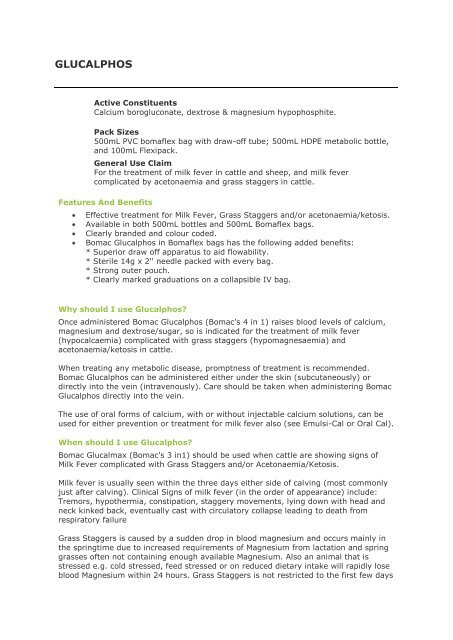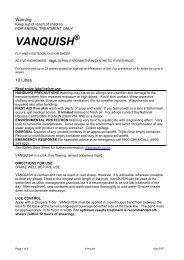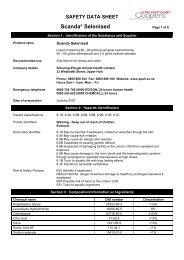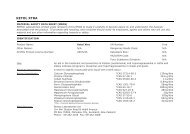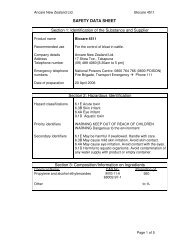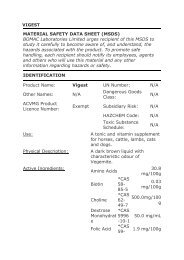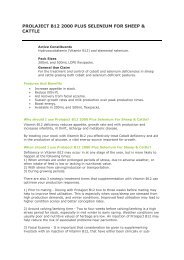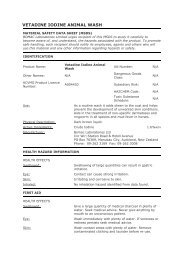GLUCALPHOS - My Farm
GLUCALPHOS - My Farm
GLUCALPHOS - My Farm
Create successful ePaper yourself
Turn your PDF publications into a flip-book with our unique Google optimized e-Paper software.
<strong>GLUCALPHOS</strong><br />
Active Constituents<br />
Calcium borogluconate, dextrose & magnesium hypophosphite.<br />
Pack Sizes<br />
500mL PVC bomaflex bag with draw-off tube; 500mL HDPE metabolic bottle,<br />
and 100mL Flexipack.<br />
General Use Claim<br />
For the treatment of milk fever in cattle and sheep, and milk fever<br />
complicated by acetonaemia and grass staggers in cattle.<br />
Features And Benefits<br />
Effective treatment for Milk Fever, Grass Staggers and/or acetonaemia/ketosis.<br />
Available in both 500mL bottles and 500mL Bomaflex bags.<br />
Clearly branded and colour coded.<br />
Bomac Glucalphos in Bomaflex bags has the following added benefits:<br />
* Superior draw off apparatus to aid flowability.<br />
* Sterile 14g x 2'' needle packed with every bag.<br />
* Strong outer pouch.<br />
* Clearly marked graduations on a collapsible IV bag.<br />
Why should I use Glucalphos?<br />
Once administered Bomac Glucalphos (Bomac's 4 in 1) raises blood levels of calcium,<br />
magnesium and dextrose/sugar, so is indicated for the treatment of milk fever<br />
(hypocalcaemia) complicated with grass staggers (hypomagnesaemia) and<br />
acetonaemia/ketosis in cattle.<br />
When treating any metabolic disease, promptness of treatment is recommended.<br />
Bomac Glucalphos can be administered either under the skin (subcutaneously) or<br />
directly into the vein (intravenously). Care should be taken when administering Bomac<br />
Glucalphos directly into the vein.<br />
The use of oral forms of calcium, with or without injectable calcium solutions, can be<br />
used for either prevention or treatment for milk fever also (see Emulsi-Cal or Oral Cal).<br />
When should I use Glucalphos?<br />
Bomac Glucalmax (Bomac's 3 in1) should be used when cattle are showing signs of<br />
Milk Fever complicated with Grass Staggers and/or Acetonaemia/Ketosis.<br />
Milk fever is usually seen within the three days either side of calving (most commonly<br />
just after calving). Clinical Signs of milk fever (in the order of appearance) include:<br />
Tremors, hypothermia, constipation, staggery movements, lying down with head and<br />
neck kinked back, eventually cast with circulatory collapse leading to death from<br />
respiratory failure<br />
Grass Staggers is caused by a sudden drop in blood magnesium and occurs mainly in<br />
the springtime due to increased requirements of Magnesium from lactation and spring<br />
grasses often not containing enough available Magnesium. Also an animal that is<br />
stressed e.g. cold stressed, feed stressed or on reduced dietary intake will rapidly lose<br />
blood Magnesium within 24 hours. Grass Staggers is not restricted to the first few days
of lactation and occasionally occurs in Autumn (not to be confused with Ryegrass<br />
Staggers caused by certain fungal infections of grasses).<br />
Early cases of grass staggers sometimes show a spasm of the eyelid muscles resulting<br />
in a characteristic "flutter". Later hyper-irritability, muscular incoordination,<br />
convulsions and death occur. Less obvious effects of sub-clinical hypomagnesaemia are<br />
reduced growth in young animals and a reduction in milk production in lactating cows.<br />
Ketosis/Acetonaemia occurs most commonly in "relatively" underfed, early calving,<br />
high producing dairy cows about two to six weeks after calving. Ketosis is caused by a<br />
drop in blood glucose and an excessive production of ketone bodies particularly<br />
acetone, when alternate sources of energy, such as body fat, have to be used by the<br />
animal. Therefore cows calving before grass production can provide them with an<br />
adequate source of calories are very prone to succumbing to ketosis.<br />
Clinical signs of ketosis/acetonaemia range from wasting, loss of appetite, drop in milk<br />
production, sweet acetone smell in breath, urine and milk. In some cases these may<br />
also proceed to nervous system signs with tremors, blindness and aggression. Ketosis<br />
maybe associated with other diseases such as mastitis, retained foetal membranes,<br />
pneumonia etc.<br />
Where can I purchase Glucalphos?<br />
Glucalphos is available through veterinary clinics and farm merchant stores.


